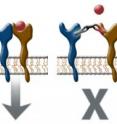'2-headed' antibody poses a double threat to breast cancer cells, say Fox Chase researchers
A small, antibody-like molecule created by researchers at Fox Chase Cancer Center can successfully attack two separate molecules on the surface of cancer cells at the same time, halting the growth of breast cancer cells in laboratory tests, the researchers say. The molecule, nickname "ALM," might be a means of slowing cancer spread or, as the researchers believe, a guidance system for delivering more aggressive drugs directly to cancer cells. Their findings appear in a recent issue of the British Journal of Cancer. Unlike naturally occurring antibodies, which only bind to one specific target at a time, ALM is bispecific, meaning it attaches to two separate targets simultaneously. ALM's targets are two signaling proteins, ErbB2 and ErbB3, which connect to form a growth-promoting complex on the surface of many cancer cells, including head and neck cancer and drug-resistant breast cancer.
"ALM grabs the ErbB2-ErbB3 complex strongly with both hands, as it were, providing a solid grip on the tumor and blocking the transmission of a growth signal within the cell," said lead investigator Matthew Robinson, Ph.D., an associate member of Fox Chase and a researcher in the Fox Chase Head and Neck Cancer Keystone Program. "Potentially, it can become a platform for delivering therapeutics directly to cancer cells or a way of detecting the presence and location of individual tumors."
ErbB2 and ErbB3 are the protein products of two known cancer-related genes, Her2 and Her3, respectively. In normal cells, the ErbB family of proteins has a role in regulating cell growth and survival. Some cancerous cells overproduce copies of ErbB2 and ErbB3, and these excess proteins can bind to each other in a way that generates further cancer-promoting growth signals within a cell. While it is possible that the bound receptor proteins might be found on normal cells, cancer cells possess up to 18 times more of these receptors.
"Because tumors that express the ErbB2-ErbB3 complex are highly aggressive and prone to relapse after initial treatment, this subset of cancer is associated with metastasis and poor patient outcome," Robinson says.
ALM was developed over many years at Fox Chase in the laboratory of co-author Greg Adams, Ph.D., in collaboration with James Marks, M.D., Ph.D., of the University of California, San Francisco, and Louis Weiner, M.D., a former Fox Chase senior member and current director of the Lombardi Comprehensive Cancer Center at Georgetown University. The Adams lab created ALM by taking the active anti-ErbB2 portion from one antibody and linking it with the anti-ErbB3 portion from another.
"ALM is a fraction of the size and weight of a naturally occurring antibody and uniquely suited for its task," Robinson says. "In essence, it can get between ErbB2 and ErbB3 and hold them apart at arm's length, much like you would if you were separating two fighting children."
In their experiments, Robinson and his colleagues examined the ability of ALM to distinguish cancer cells from normal cells in cell culture and in a mouse model of disease. They found that ALM preferentially selects tumor cells that express the receptor complex over normal cells that express low levels of both receptors individually.
However, treatment with ALM, by itself, is not really practical, according to Robinson. "As a therapeutic, ALM would need to be taken daily, since it would be rapidly cleared from the body," Robinson says. "While ALM can stop cancer cells from growing and possibly even spreading, it only has a modest ability to kill cancer cells."
In the effort to kill cancer cells, Robinson says, it might be best not to think of ALM as a warrior but as a delivery system. The small amino acid chain that links its two active areas can also serve as a trailer hitch for stronger, more effective cancer-killing drugs.
"Since ALM is so specific for its target – and since its target is only found in great numbers on cancer cells – it could be used to tow what would otherwise be considered toxic therapeutics directly to cancer cells, without harming nearby healthy cells," Robinson says. "We are currently investigating how best to tether other molecules to the antibody in order to target metastatic breast cancer and related diseases."
According to Robinson, ALM might also provide a platform for diagnosing cancer. By conjugating the antibody with a marker molecule, ALM could be used to detect small cancers early or to determine the extent of cancer spread. Robinson and his colleagues are currently studying ALM's diagnostic and therapeutic potential.
Source: Fox Chase Cancer Center
Articles on the same topic
- UM researchers ID molecule linked to aggressive cancer growth, spreadThu, 13 Nov 2008, 19:37:39 UTC
Other sources
- '2-headed' antibody poses a double threat to breast cancer cellsfrom PhysorgThu, 13 Nov 2008, 23:07:23 UTC
- Researchers ID molecule linked to aggressive cancer growth, spreadfrom PhysorgThu, 13 Nov 2008, 19:21:10 UTC
